Wednesday, January 15th, 2020.
In this Daily: The Reptiles of the Tropical Dry Forest Reserve
Guanacaste’s warm and sunny summer days bring increased activity from the reptiles in the 1000 acre tropical dry forest reserve in town, like the Black Iguana, the Barred Ameiva, the Deppe’s Whiptail Lizard, and the Painted Wood Turtle, which were all documented during phase one of the wildlife monitoring collaboration going on in the reserve.
Iguana Negra / Black Iguana (Ctenosaura similis)
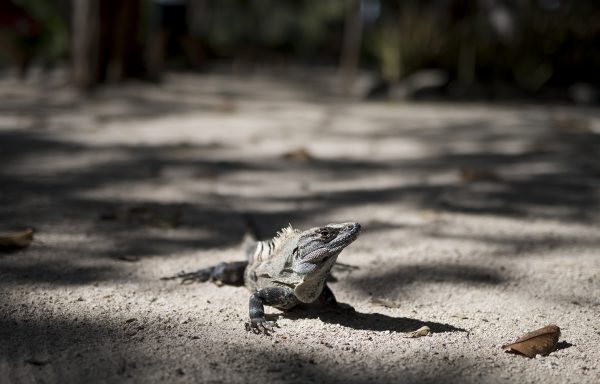 A Black Iguana
A Black Iguana
Description: The most recognizable reptiles around town are the Black Iguanas, which live throughout the reserve and can be found along the beachfront. Ranging from around 18in from tip to tail as juveniles to large bull males, which can grow up to more than 4 feet long, black iguanas all have black scales, with a wide variety of markings and colorations that can be white, cream colored, peach, gray or even light blue, like above. The dorsal spines, for which they are often called “spiny-tailed iguanas” are more prominent in males.
Found Natively: From the Isthmus of Tehuantepec in Mexico as far south as Colombia
Activity: Black iguanas are most active throughout the day, and can be seen throughout town basking in the sun, snacking on flowers and fruits, climbing trees, and hiding among rocks and shrubs.
Notable Behaviors: Black iguanas are very territorial creatures regardless of gender, relying on struggles for territory and displays of dominance (reaching a high point and head bobbing) as key parts of mating rituals. Both fighting and mating rituals often involve quick sprints, during which iguanas will take off running across the ground.
Interesting Facts: The black iguana is the fastest-moving lizard in the world, once clocked at up to 35 km/hr by researchers. This speed primarily helps them get away from predators, as they are not known to be particularly active hunters.
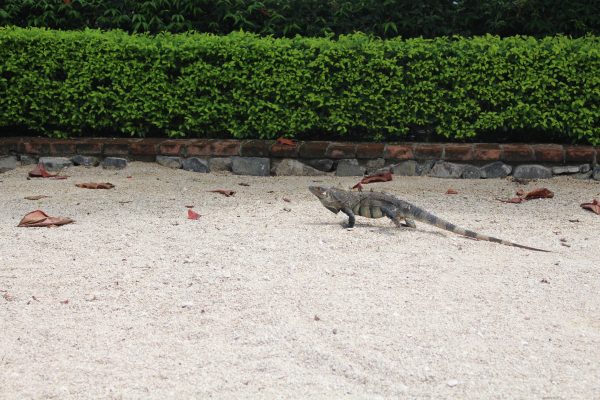 Black Iguanas can be found throughout town, especially along the beachfront, where they often jostle for territory
Black Iguanas can be found throughout town, especially along the beachfront, where they often jostle for territory
Corredor de Arco Iris / Barred Ameiva or Rainbow Racerunner (Holcosus Undulatus)
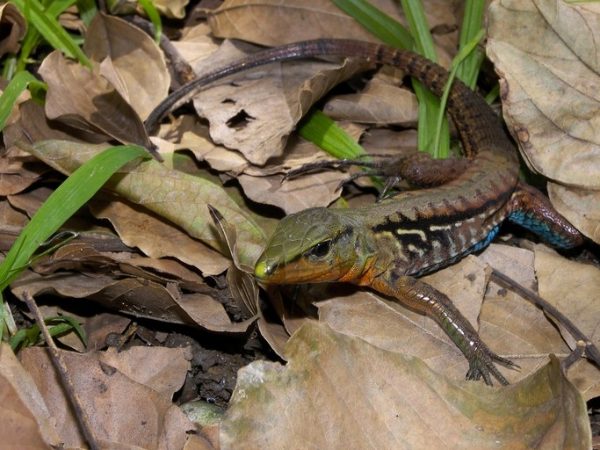 A Barred Ameiva or Rainbow Racerunner | PC: Commons
A Barred Ameiva or Rainbow Racerunner | PC: Commons
Description: The barred ameiva, also known as the rainbow racerunner, is one variation of the whiptail lizards, a group of several different lizards found throughout Central America characterized by their thin bodies, low-to-the-ground profile, and long, whip-like tail. Also called the rainbow ameiva or the metallic ameiva, the barred ameiva is small (between 5 and 6 inches long) and primarily brown coloured, with darker bars running down its sides, as well as markings on its sides and underside that can be light blue, green, red, and orange.
Found Natively: From Central Mexico to Northwestern Costa Rica, primarily in drier forest habitats at a wide variety of elevations
Activity: The barred ameiva is typically active during the day, where it forages for insects along the forest floor, using its colorations to disguise itself among the leaf litter from predators.
Notable Behaviors: Barred Ameivas, like many of their fellow whiptails, tend to be very active as they forage, darting from cover to cover along the leaf litter. This makes the summer a more likely time to spot them, as the very subtle aural cues of their movement can be amplified by the drier leaves on the ground.
Interesting Facts: Though the whiptail lizard family are not the fastest lizards on the planet in terms of top speed (a title taken by the black iguana), there is a reason that they are called racerunners. These 5 to 6 in long creatures are capable of reaching a top speed of up to 17 miles per hour, a speed-to-size ratio among the top in the animal kingdom. To scale, a human sprinter would have to run approximately 255 mph (410km/h) to match the rainbow racerunner.
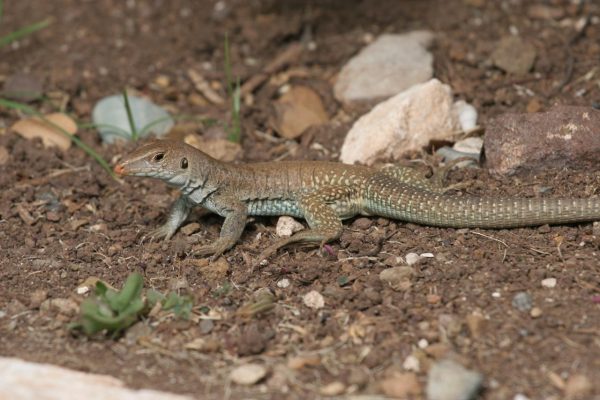 Barred Ameivas have a wide range of different colorations, and are part of a large family of whiptail lizards | PC : Commons
Barred Ameivas have a wide range of different colorations, and are part of a large family of whiptail lizards | PC : Commons
Lagarto de Cola Látigo de Deppe / Deppe’s Whiptail Lizard (Aspidoscelis deppei)
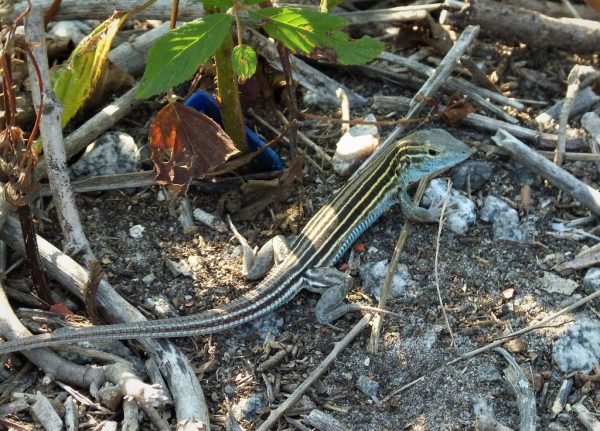 A Deppe's Whiptail Lizard | PC: Commons
A Deppe's Whiptail Lizard | PC: Commons
Description: Deppe’s Whiptail Lizard is another variation of the whiptails found in Central America, with well-developed legs, a long tail, and measures 5 to 6 in from tip to tail. Deppe’s Whiptail Lizard is distinguished from the Barred Ameiva by the seven long stripes running along the lizard’s body from head to tail, very similar to that of the 6-striped Whiptail Lizard.
Found Natively: Throughout Central America, in drier habitats, including up to the Southern United States
Activity: Many whiptails follow a similar pattern of movement and activity, especially those within the same region. During the daytime, these lizards dart from cover to cover through the leaf litter as they search for bugs, before hiding for the nighttime.
Notable Behaviors: Deppe’s Whiptail Lizards are frequently on the move between areas of shade and sun, a required shift for thermoregulation. Between their periods of frequent movement as they search for food sources like ants, grubs, and other bugs in the shade and leaf litter, Deppe’s Whiptail Lizards then sun themselves on logs, rocks, and branches. This presents a chance to spot them, as their vibrant colors are visible in the sunlight.
Interesting Facts: Many species and subspecies within the whiptail lizard families produce unisexually through a process called parthenogenesis, in which a female provides both chromosomes for the offspring, but in a mixed distribution such that offspring are different from their parent.
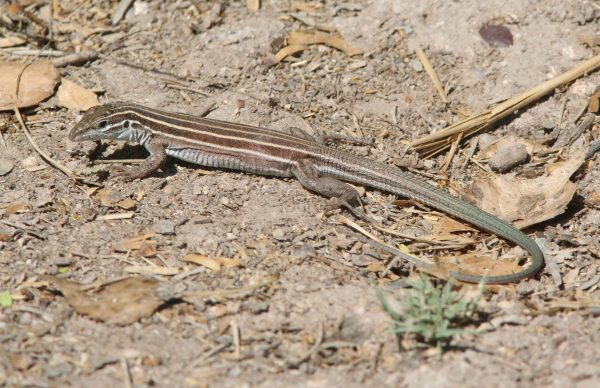 Many species within the family of whiptail lizards are parthenogenic, all-female species that produce via unisexual hybridization | PC: Commons
Many species within the family of whiptail lizards are parthenogenic, all-female species that produce via unisexual hybridization | PC: Commons
Tortuga Roja / Painted Wood Turtle (Rhinoclemmys pulcherrima)
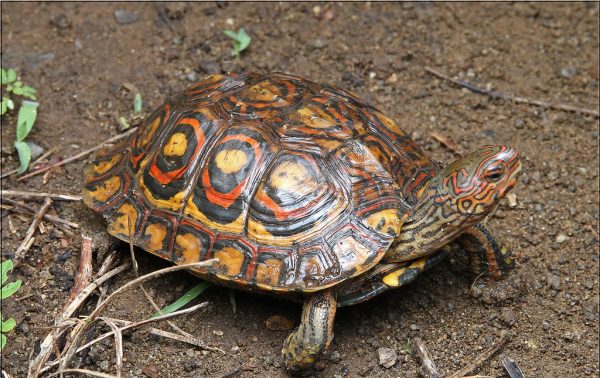 A Painted Wood Turtle | PC: Commons
A Painted Wood Turtle | PC: Commons
Description: Painted wood turtles are notable for their very prominent colorations, which are thought to appear painted on. These turtles can grow to a maximum length of 20 cm with a dome-shaped carapace, and a slight ridge running from front to back on their shells.
Found Natively: In a wide variety of forested habitats, found as far north as Sonora, Mexico and as far south as Costa Rica
Activity: Painted wood turtles are diurnal, and typically forage throughout the day for insects, worms, and small fruits on the forest floor, in bushes, and in shallow rivers. Though they are mostly terrestrial, these turtles are capable swimmers, and will cross shallow streams and rivers comfortably.
Notable Behaviors: Many species of painted turtle can hibernate during the winter, stockpiling food and then burrowing underground to avoid the cold winter months. However, despite having this ability, the painted wood turtle does not hibernate in Central America, as the temperature does not get low enough that they feel the need to do so, so these turtles can be spotted year-round
Interesting Facts: There are four known subspecies of Painted Wood Turtle, and each has differing levels of colorations based on the nature of the plants in their habitats. For example, Nicaraguan varieties of the Painted Wood Turtle are known to have very muted coloring, while the Costa Rican variety are known for their very brightly colored shells, which especially help them stay hidden among the forest floor during Guanacaste’s dry season.
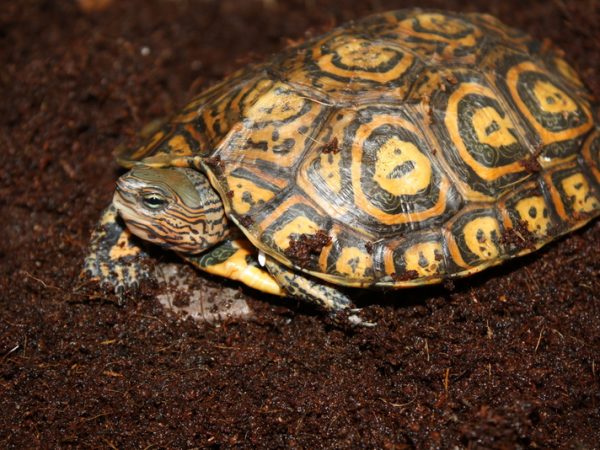 Different subspecies of the Painted Wood Turtle have adapted various colorings to blend into the forest floor in various habitats. In Costa Rica, the brightly colored foliage on the forest floor, especially in places like Guanacaste during the dry season, has given rise to vibrantly colored shells on Painted Wood Turtles
Different subspecies of the Painted Wood Turtle have adapted various colorings to blend into the forest floor in various habitats. In Costa Rica, the brightly colored foliage on the forest floor, especially in places like Guanacaste during the dry season, has given rise to vibrantly colored shells on Painted Wood Turtles
Take a Walk in the Reserve and See These Reptiles in Costa Rica
These reptiles are all more active in the summer months due to the increased sunshine and warm temperatures, which causes many changes in the behaviors of animals throughout the reserve. For a chance to see some of these elusive reptiles in the wild, as well as some of the many other animals in the reserve, simply step out onto the trails at Las Catalinas, which are just a short walk from your front door.
[maxbutton id="1" url="https://cta-redirect.hubspot.com/cta/redirect/4917861/bb90976c-fd33-457a-a285-892e384bad66" text="Visit Las Catalinas" ]
Footage of some animals from the reserve